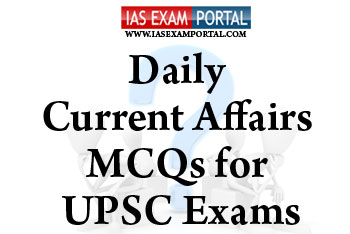(HOT) UPSC Current Affairs 2025 PDF
NEW! The Gist (OCT-2025) | E-BOOKS
Current Affairs MCQ for UPSC Exams - 09 April 2019
Current Affairs MCQ for UPSC Exams - 09 April 2019
Q1. Which of the following statements regarding consumer protection In India are true ?
1) The Consumer Protection Act was passed in 1986 to protect the interests of
the consumers. The objective of this law is to provide a simple, fast and
inexpensive mechanism to the citizens to redress their grievances in specified
cases.
2) In order to help achieve the objects of the Consumer Protection Act, the
National Commission has also been conferred with the power of administrative
control over all the State Commissions by calling for periodical returns
regarding the institution, disposal and pendency of cases.
3) NCDRC is quasi-judicial commission headed by sitting or retired judge of
Supreme Court of India,any person aggrieved by order of NCDRC, may appeal
against such order to Supreme Court within period of 30 days.
a) 1 & 2 only
b) 2 & 3 only
c) 1 & 3 only
d) all of the above
Q2. Which of the following languages are not amongst those included in the 8th schedule of the constitution ?
1) Sanskrit
2) Kodava
3) Assamese
4) Lushai
5) Dogri
a) 1,2& 3 only
b) 3,4 & 5 only
c) 2 & 4 only
d) 1,3 & 5 only
Q3. Consider the following statements with respect to National Mission for Manuscripts (NMM) :
1) In 2003, National Mission for Manuscripts (NMM), a Mission mode Project,
was launched by the Ministry of Culture for documentation, conservation,
preservation and digitization of manuscripts.
2) The main aim of the project is to enhance their access, awareness and use for
educational purposes.
3) Indira Gandhi National Centre for the Arts (IGNCA) is the nodal agency for
the execution of this project.
a) 1 & 2 only
b) 2 & 3 only
c) 1 & 3 only
d) all of the above
Q4. Which of the following statements regarding India-Nepal geography are not true ?
1) Nepal rests on a major fault line between two tectonic plates: one bearing
India that pushes against the other carrying Europe and Asia, the process that
created the Himalayas.
2) Also,within the Himalayan region of Nepal which is used as main trade route
between India and Tibet gorges are completely absent.
3) The Tarai Region (in the south) along the border with India, is a low stretch
of land, containing Nepal's highest point: KanchanKalan.
a) 1 & 2 only
b) 2 & 3 only
c) 1 & 3 only
d) all of the above
Q5. Which of the following is considered as the first comprehensive plan for the spread of education in India ?
a) MaCaulays minute
b) Woods despatch1854
c) Charter act 1813
d) University’s act 1904


